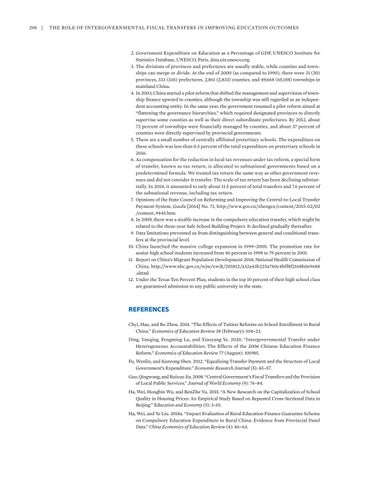298 | The Role of Intergovernmental Fiscal Transfers in Improving Education Outcomes
2. Government Expenditure on Education as a Percentage of GDP, UNESCO Institute for Statistics Database, UNESCO, Paris, data.uis.unesco.org. 3. The divisions of provinces and prefectures are usually stable, while counties and townships can merge or divide. At the end of 2000 (as compared to 1990), there were 31 (30) provinces, 333 (336) prefectures, 2,861 (2,833) counties, and 49,668 (65,188) townships in mainland China. 4. In 2003, China started a pilot reform that shifted the management and supervision of township finance upward to counties, although the township was still regarded as an independent accounting entity. In the same year, the government resumed a pilot reform aimed at “flattening the governance hierarchies,” which required designated provinces to directly supervise some counties as well as their direct subordinate prefectures. By 2012, about 72 percent of townships were financially managed by counties, and about 37 percent of counties were directly supervised by provincial governments. 5. There are a small number of centrally affiliated pretertiary schools. The expenditure on these schools was less than 0.5 percent of the total expenditure on pretertiary schools in 2016. 6. As compensation for the reduction in local tax revenues under tax reform, a special form of transfer, known as tax return, is allocated to subnational governments based on a predetermined formula. We treated tax return the same way as other government revenues and did not consider it transfer. The scale of tax return has been declining substantially. In 2018, it amounted to only about 11.5 percent of total transfers and 7.6 percent of the subnational revenue, including tax return. 7. Opinions of the State Council on Reforming and Improving the Central-to-Local Transfer Payment System, Guofa [2014] No. 71, http://www.gov.cn/zhengce/content/2015-02/02 /content_9445.htm. 8. In 2009, there was a sizable increase in the compulsory education transfer, which might be related to the three-year Safe School Building Project. It declined gradually thereafter. 9. Data limitations prevented us from distinguishing between general and conditional transfers at the provincial level. 10. China launched the massive college expansion in 1999–2005. The promotion rate for senior high school students increased from 46 percent in 1998 to 79 percent in 2001. 11. Report on China’s Migrant Population Development 2018, National Health Commission of China, http://www.nhc.gov.cn/wjw/xwdt/201812/a32a43b225a740c4bff8f2168b0e9688 .shtml. 12. Under the Texas Ten Percent Plan, students in the top 10 percent of their high school class are guaranteed admission to any public university in the state.
REFERENCES Chyi, Hau, and Bo Zhou. 2014. “The Effects of Tuition Reforms on School Enrollment in Rural China.” Economics of Education Review 38 (February): 104–23. Ding, Yanqing, Fengming Lu, and Xiaoyang Ye. 2020. “Intergovernmental Transfer under Heterogeneous Accountabilities: The Effects of the 2006 Chinese Education Finance Reform.” Economics of Education Review 77 (August): 101985. Fu, Wenlin, and Kunrong Shen. 2012. “Equalizing Transfer Payment and the Structure of Local Government’s Expenditure.” Economic Research Journal (5): 45–57. Guo, Qingwang, and Ruixue Jia. 2008. “Central Government’s Fiscal Transfers and the Provision of Local Public Services.” Journal of World Economy (9): 74–84. Ha, Wei, Hongbin Wu, and RenZhe Yu. 2015. “A New Research on the Capitalization of School Quality in Housing Prices: An Empirical Study Based on Repeated Cross-Sectional Data in Beijing.” Education and Economy (5): 3–10. Ha, Wei, and Ye Liu. 2018a. “Impact Evaluation of Rural Education Finance Guarantee Scheme on Compulsory Education Expenditure in Rural China: Evidence from Provincial Panel Data.” China Economics of Education Review (4): 46–63.






